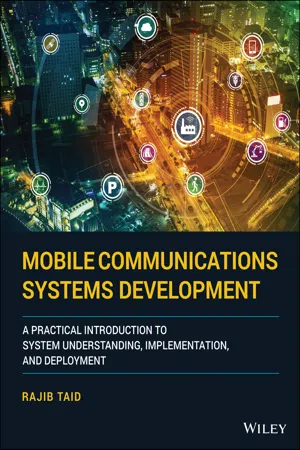
Mobile Communications Systems Development
A Practical Introduction to System Understanding, Implementation and Deployment
- English
- ePUB (mobile friendly)
- Available on iOS & Android
Mobile Communications Systems Development
A Practical Introduction to System Understanding, Implementation and Deployment
About this book
Provides a thorough introduction to the development, operation, maintenance, and troubleshooting of mobile communications systems
Mobile Communications Systems Development: A Practical Introduction for System Understanding, Implementation, and Deployment is a comprehensive "how to" manual for mobile communications system design, deployment, and support. Providing a detailed overview of end-to-end system development, the book encompasses operation, maintenance, and troubleshooting of currently available mobile communication technologies and systems. Readers are introduced to different network architectures, standardization, protocols, and functions including 2G, 3G, 4G, and 5G networks, and the 3GPP standard.
In-depth chapters cover the entire protocol stack from the Physical (PHY) to the Application layer, discuss theoretical and practical considerations, and describe software implementation based on the 3GPP standardized technical specifications. The book includes figures, tables, and sample computer code to help readers thoroughly comprehend the functions and underlying concepts of a mobile communications network. Each chapter includes an introduction to the topic and a chapter summary. A full list of references, and a set of exercises are also provided at the end of the book to test comprehension and strengthen understanding of the material. Written by a respected professional with more than 20 years' experience in the field, this highly practical guide:
- Provides detailed introductory information on GSM, GPRS, UMTS, and LTE mobile communications systems and networks
- Describes the various aspects and areas of the LTE system air interface and its protocol layers
- Covers troubleshooting and resolution of mobile communications systems and networks issues
- Discusses the software and hardware platforms used for the development of mobile communications systems network elements
- Includes 5G use cases, enablers, and architectures that cover the 5G NR (New Radio) and 5G Core Network
Mobile Communications Systems Development is perfect for graduate and postdoctoral students studying mobile communications and telecom design, electronic engineering undergraduate students in their final year, research and development engineers, and network operation and maintenance personnel.
Frequently asked questions
- Essential is ideal for learners and professionals who enjoy exploring a wide range of subjects. Access the Essential Library with 800,000+ trusted titles and best-sellers across business, personal growth, and the humanities. Includes unlimited reading time and Standard Read Aloud voice.
- Complete: Perfect for advanced learners and researchers needing full, unrestricted access. Unlock 1.4M+ books across hundreds of subjects, including academic and specialized titles. The Complete Plan also includes advanced features like Premium Read Aloud and Research Assistant.
Please note we cannot support devices running on iOS 13 and Android 7 or earlier. Learn more about using the app.
Information
1
Introduction : Career Opportunities in Mobile Communications Networks Space
You see, wire telegraph is a kind of a very, very long cat. You pull his tail in New York; and his head is meowing in Los Angeles. Do you understand this? And radio operates exactly the same way: you send signals here, they receive them there. The only difference is that there is no cat.Source: Albert Einstein.

Part I
Network Architectures, Standardization, Protocols, and Functions
2
Network Architectures, Standardizations Process
Introduction
Table of contents
- Cover
- Table of Contents
- Title Page
- Copyright Page
- About the Author
- Preface
- Acknowledgments
- List of Abbreviations
- 1 Introduction
- Part I: Network Architectures, Standardization, Protocols, and Functions
- Part II: Operations and Maintenances
- Part III: Mobile Communications Systems Development
- Part IV: 5G System and Network
- Test Yourself!
- References
- Index
- End User License Agreement